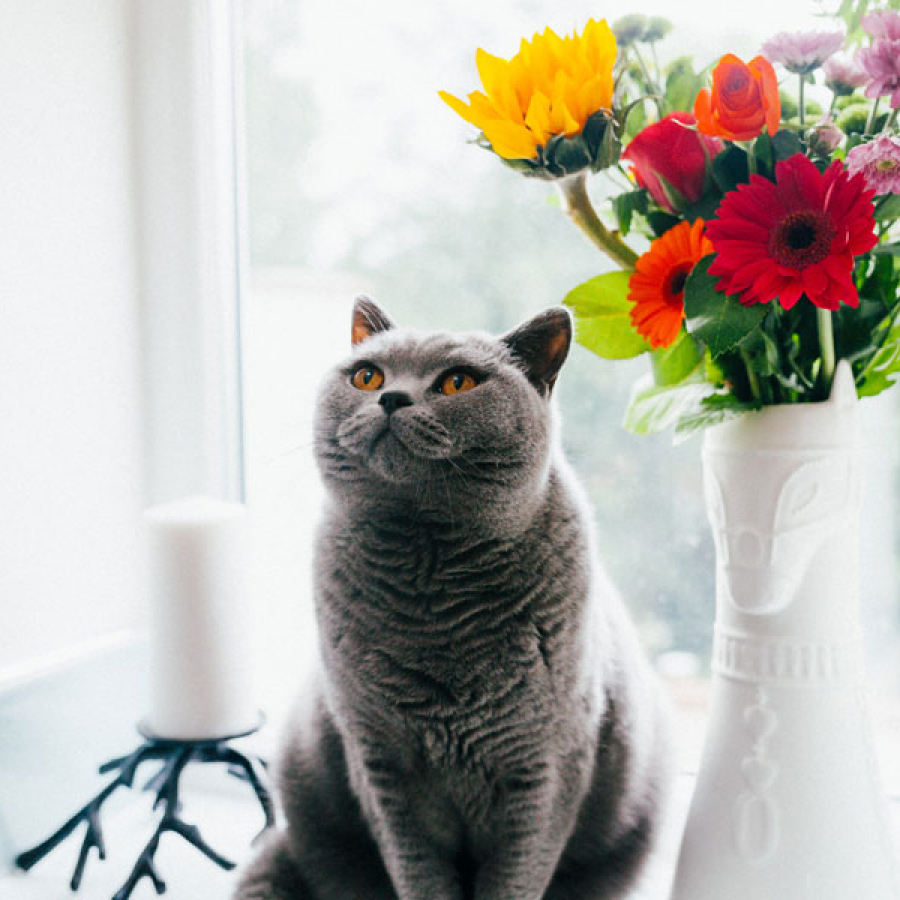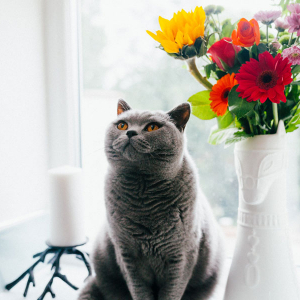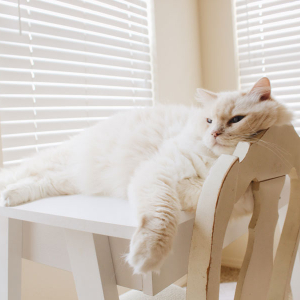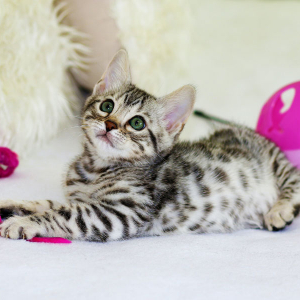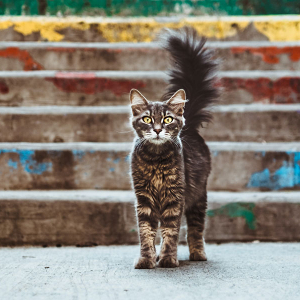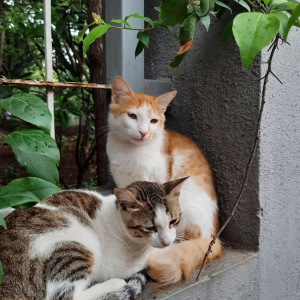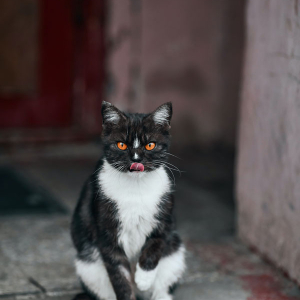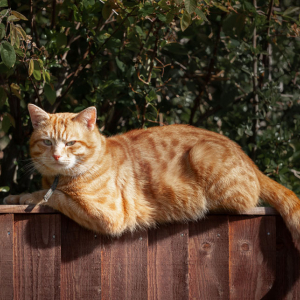Stories have often depicted cats as independent, living on a farm or outside in an urban setting. Occasionally the cat would come inside for a bowl of milk, take a nap on the rug then return outside. Before domestication, cats were outdoor animals, and now they are classified as a cosmopolitan species. Cat owners often wonder: what is the ideal cat habitat? Should Kitty have the freedom to go outside or is inside better? Considering cats were domesticated over 8,000 years ago, cat habitats have evolved greatly.
Archaeologists discovered mummified cats buried with their owners in Egypt dating back to 1350 B.C. Therefore, it was believed that cat domestication began in Egypt. Later archaeologists unveiled the skeleton of an African Wildcat, dating around 7500 B.C., buried next to a human in Cyprus. An island in the eastern Mediterranean Sea, Cyprus is not known to have indigenous mammalian wildlife; therefore, scientists believe the 8-month-old wildcat and humans traveled to Cyprus from Europe.
Approximately 12,000 years ago, our human hunter-gatherer lifestyle evolved into permanent agricultural settlements with reliable food supplies. The development of agriculture meant stored grain, which attracted rodents. The increase in the rodent population among human settlements spread disease. Because cats hunted rodents, humans could domesticate them to catch rats and prevent illness. The cats lived outside, serving humans and developing the relationship with them we have today.
As humans expanded their societies to other continents and islands, cats became an everyday part of life. Currently, cats live on every continent and 118 major island groups, except Antarctica. The cat’s ability, like humans, to adjust to various climates (from hot deserts, cities, farmlands, mountains and more) make for a perfect partnership. This trait also includes cats with the orca as a cosmopolitan species—yes, I said orca—as in whale!
Fast-forward to present day, where our cosmopolitan species is worshipped to the tune of approximately $99 billion dollars per year. Cat owners are not afraid to buy the best foods, treats and toys for their feline companion(s). Owners are also always looking for the finest in kitty comfort. Whether your kitty lives the indoor life, outdoor life or a bit of both, there are many options available.
Often when you think of an outdoor kitty, you associate it with a colony. These kitties tend to surf from porch to porch, looking for the best foods and sometimes the poshest beds. They may not want pets or cuddles, but they greatly appreciate fresh food, water, spay/neuter and safe space to nap. Some people embrace a cat’s love for boxes and line a cardboard box with cozy blankets and towels, while others purchase outdoor heated kitty houses. When offering your community cats comfort, be sure to consider some of these options. First, find a place that is already a comfortable area for them, preferably an area away from traffic and neighbors (if possible). Make sure the shelter is waterproof, windproof and off the ground. The entrance should be about 6 to 8 inches to help keep other animals out. Reduce the elements from coming in by installing a flap on the entrance or make the shelter L-shaped. When preparing bedding, consider material that will not encourage dampness. Straw is a great material because it does not encourage dampness like hay, towels, or blankets. Once the shelter is set up, it’s time to camouflage! You can paint the shelter a dark color and add leaves or brush to help make it a safe camouflaged space. When everything is ready for kitties to move in, leaving catnip inside will help encourage them to use the shelter. Also, be sure to check the shelter regularly to make sure everything is in working order. When you decide your cat will have the best of both worlds, creating indoor and outdoor comforts can be a rather different task. Indoor kitties tend to embrace human comforts. They love nap time in their human’s bed, on a blanket, in a box or basket or on their human’s keyboard during a video meeting. Many people purchase kitty condos, or cat trees, allowing their feline to climb, scratch, cuddle in a box and get a bird’s eye view of the household. Cat condos, or cat trees, are available in many different heights with various materials. If the owner doesn’t want Kitty to go outside at all, but still to remain active, a cat exercise wheel is a great purchase. Place it next to your exercise bike or treadmill, and you and kitty can exercise together! A CatTV is another perk that may help entertain your cat with videos of birds, fish and other things that cats like. Cat tunnels are a fun option and have interactive toys like lasers. Since cats are natural-born sunbathers, cat perches on your windows offer natural views of birds and bugs with a sunny spot for napping. Screened porches, or catios, are also loved by many. Catios can connect to a window, door or cat door. Usually, they are made of screen or chicken wire and allow the kitty protected outdoor time. A catio usually include both shaded and sunny spots, places to climb and places to cuddle for a nap. There are many options to learn to build one yourself, or to have someone build for you, and are a great option for protected outdoor time.
If a catio is not an option for you and Kitty, but you want Kitty to have outside time, finding an indoor/outdoor routine may be the answer. Some kitties like their own pet door and the freedom to come and go as they please. Other kitties like to meow at their owners when they are ready to go out or come in (self-service is just not their style). Most indoor/outdoor kitties come inside for bad weather or at night, but some like to have an outdoor space in case human/kitty schedules conflict. Always be prepared to offer your outdoor kitty a safe space to go when you are not home. You can always keep a shelter in your yard or on your porch like the one mentioned for community cats. Encouraging the kitty to stay close to home with food which is kept inside will help create a routine. Another option is a cat-proof fence. They can be installed with an existing fence or stand alone and are considered escape-proof. Of course, always research your options for those that best fit your environment.
Some cats embrace their instinctual characteristics and insist on outside time, while others are quite content with their inside life. When deciding, be sure to discuss the pros and cons with your veterinarian, consider your comfort level and what is best for your kitty. Our kitties bring us love and companionship which we reciprocate with love and care. Be sure to provide them with what they need to ensure a happy, healthy kitty life.
Archaeologists discovered mummified cats buried with their owners in Egypt dating back to 1350 B.C. Therefore, it was believed that cat domestication began in Egypt. Later archaeologists unveiled the skeleton of an African Wildcat, dating around 7500 B.C., buried next to a human in Cyprus. An island in the eastern Mediterranean Sea, Cyprus is not known to have indigenous mammalian wildlife; therefore, scientists believe the 8-month-old wildcat and humans traveled to Cyprus from Europe.
Approximately 12,000 years ago, our human hunter-gatherer lifestyle evolved into permanent agricultural settlements with reliable food supplies. The development of agriculture meant stored grain, which attracted rodents. The increase in the rodent population among human settlements spread disease. Because cats hunted rodents, humans could domesticate them to catch rats and prevent illness. The cats lived outside, serving humans and developing the relationship with them we have today.
As humans expanded their societies to other continents and islands, cats became an everyday part of life. Currently, cats live on every continent and 118 major island groups, except Antarctica. The cat’s ability, like humans, to adjust to various climates (from hot deserts, cities, farmlands, mountains and more) make for a perfect partnership. This trait also includes cats with the orca as a cosmopolitan species—yes, I said orca—as in whale!
Fast-forward to present day, where our cosmopolitan species is worshipped to the tune of approximately $99 billion dollars per year. Cat owners are not afraid to buy the best foods, treats and toys for their feline companion(s). Owners are also always looking for the finest in kitty comfort. Whether your kitty lives the indoor life, outdoor life or a bit of both, there are many options available.
Often when you think of an outdoor kitty, you associate it with a colony. These kitties tend to surf from porch to porch, looking for the best foods and sometimes the poshest beds. They may not want pets or cuddles, but they greatly appreciate fresh food, water, spay/neuter and safe space to nap. Some people embrace a cat’s love for boxes and line a cardboard box with cozy blankets and towels, while others purchase outdoor heated kitty houses. When offering your community cats comfort, be sure to consider some of these options. First, find a place that is already a comfortable area for them, preferably an area away from traffic and neighbors (if possible). Make sure the shelter is waterproof, windproof and off the ground. The entrance should be about 6 to 8 inches to help keep other animals out. Reduce the elements from coming in by installing a flap on the entrance or make the shelter L-shaped. When preparing bedding, consider material that will not encourage dampness. Straw is a great material because it does not encourage dampness like hay, towels, or blankets. Once the shelter is set up, it’s time to camouflage! You can paint the shelter a dark color and add leaves or brush to help make it a safe camouflaged space. When everything is ready for kitties to move in, leaving catnip inside will help encourage them to use the shelter. Also, be sure to check the shelter regularly to make sure everything is in working order. When you decide your cat will have the best of both worlds, creating indoor and outdoor comforts can be a rather different task. Indoor kitties tend to embrace human comforts. They love nap time in their human’s bed, on a blanket, in a box or basket or on their human’s keyboard during a video meeting. Many people purchase kitty condos, or cat trees, allowing their feline to climb, scratch, cuddle in a box and get a bird’s eye view of the household. Cat condos, or cat trees, are available in many different heights with various materials. If the owner doesn’t want Kitty to go outside at all, but still to remain active, a cat exercise wheel is a great purchase. Place it next to your exercise bike or treadmill, and you and kitty can exercise together! A CatTV is another perk that may help entertain your cat with videos of birds, fish and other things that cats like. Cat tunnels are a fun option and have interactive toys like lasers. Since cats are natural-born sunbathers, cat perches on your windows offer natural views of birds and bugs with a sunny spot for napping. Screened porches, or catios, are also loved by many. Catios can connect to a window, door or cat door. Usually, they are made of screen or chicken wire and allow the kitty protected outdoor time. A catio usually include both shaded and sunny spots, places to climb and places to cuddle for a nap. There are many options to learn to build one yourself, or to have someone build for you, and are a great option for protected outdoor time.
If a catio is not an option for you and Kitty, but you want Kitty to have outside time, finding an indoor/outdoor routine may be the answer. Some kitties like their own pet door and the freedom to come and go as they please. Other kitties like to meow at their owners when they are ready to go out or come in (self-service is just not their style). Most indoor/outdoor kitties come inside for bad weather or at night, but some like to have an outdoor space in case human/kitty schedules conflict. Always be prepared to offer your outdoor kitty a safe space to go when you are not home. You can always keep a shelter in your yard or on your porch like the one mentioned for community cats. Encouraging the kitty to stay close to home with food which is kept inside will help create a routine. Another option is a cat-proof fence. They can be installed with an existing fence or stand alone and are considered escape-proof. Of course, always research your options for those that best fit your environment.
Some cats embrace their instinctual characteristics and insist on outside time, while others are quite content with their inside life. When deciding, be sure to discuss the pros and cons with your veterinarian, consider your comfort level and what is best for your kitty. Our kitties bring us love and companionship which we reciprocate with love and care. Be sure to provide them with what they need to ensure a happy, healthy kitty life.
Tagged in Kitty Korner in our Fall 2022 issue
